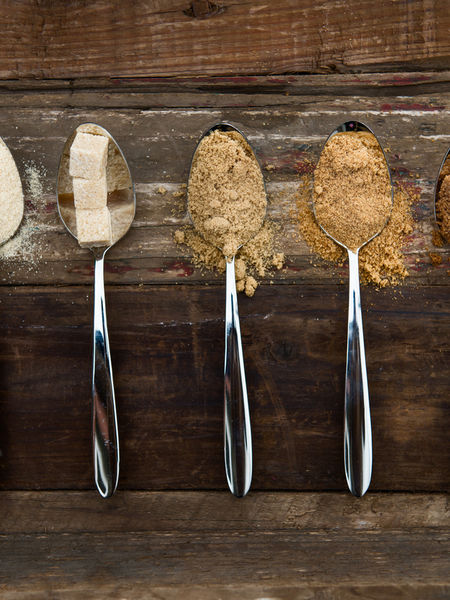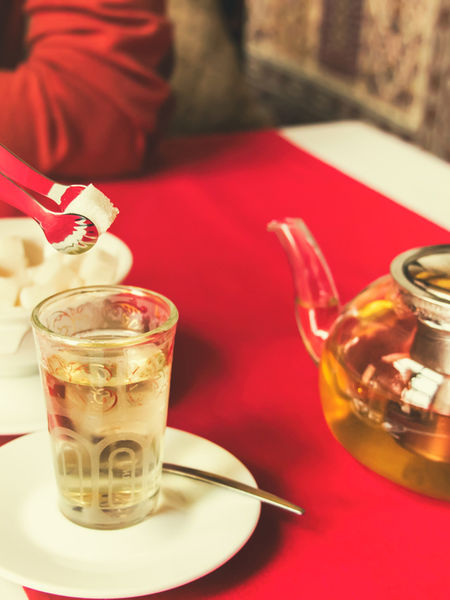Sweeteners for Tea: Ideas Old, New, and Unusual


From the 15th and 16th centuries onward, both sugar and tea were sought after for their flavor, and perhaps more importantly, for their status because they were so expensive. Enjoying, and serving, tea and sugar demonstrated to guests that their hosts were wealthy enough to afford them both but not so cavalier that they would entrust the servants to prepare the beverage. It was not unusual to find British or Indian versions of tea tables (teapoys) outfitted with several compartments for teas and sugar, and operated with substantial locks, to prevent anyone from helping themselves to the costly tea or the sugar. The lady of the house would be the only one entrusted with the key, and often, despite her privileged position, the only one to prepare, and serve, these two costly ingredients to her grateful guests. (Servants still made and served accompaniments, of course.)
So popular were these commodities that worldwide trade became for them so intense that slavery, piracy, and other battles on land and sea would ensue through the 18th century (but that’s another story.)
Today, the range of prices and the variety of tea has cemented its reputation as the most frequently-consumed beverage in the world. And sweeteners are continuously expanding way beyond sugar cane or beet sugars. Today, you can find an incredible range of sweeteners and experience how they can enhance, or mask, the clean, brisk taste of tea. The cost of any of the following sweeteners is kind to the wallet. The flavors are anywhere from bland to intensely sweet. We give you a small glimpse:
WHITE AND BROWN SUGARS
White or brown sugars are the top sellers for tea and one can choose granulated, cubes, or crystals. Serving pretty decorated cubes or sticks of crystals adds a touch of whimsy and fun to the table service, and as always, pretty bowls are charming ways to offer granulated sugar.
White sugars are stripped of molasses and some brands are bleached. The two most common sources of white sugars are sugar cane or beets.
Brown sugars are made from spinning molasses-rich crystals until they’re dry, leaving coarse tan granules. They’re less delicate than white sugar cane granules, and add a little hearty punch of sweetness to chais, black blends, and heartier blacks like Assam, Keemun, Nilgiri or heartier Ceylon black teas.
Look for Indian jaggery, which comes in chunks of soft brown sugar or turbinado, a granulated form, both of which offer a light molasses taste. One commercial brand, Sugar in the Raw is exactly that, raw turbinado, a brown sugar.
Demerara, originally grown on the banks of the Demerara River in Guyana, is now grown in many cane-growing countries particularly Mauritius. Demerara has a subtle butterscotch aroma and dry crunchy texture.
Or, consider a dollop of thick molasses syrup, although its strong taste would certainly overpower anything but the heartiest of black teas.
SUGAR SYRUPS
Sugar syrups blend well in iced teas and chais, hot or cold. You can always make a simple sugar syrup heating1 part granulated sugar to 2 parts water until it is reduced to a thick syrup, or buy a commercial one like corn syrup, rice syrup, (aka rice malt syrup,) or Lyle’s syrup. Be aware that all these syrups have a high glycemic index (65 and up per spoonful) and are quite intense in the cup so the best match is a hearty black like an Assam versus a more delicate Darjeeling.
One syrup that does have a low glycemic index is Agave nectar (aka Agave syrup) made from the blue agave succulent that’s used in making tequila. It comes in several grades of flavor, intensity, and color with the best for tea being a light agave nectar. Use about three-fourths of a teaspoon for every teaspoon of granulated sugar you would ordinarily use.
HONEY
The variety of honeys is spectacular and buying local means you’ll get the freshest and the best tasting. However, more and more ethnic markets are stocking honeys from around the world like Leatherwood honey from Australia or ones from Greece. Mild honeys include orange blossom or wildflower; heartier ones are Tupelo, buckwheat.
Here, again, the heartier the honey, the stronger the tea you should use to avoid sweeteners overpowering the tea.
ATYPICAL SUGARS
Coconut sugar has the same number of calories as granulated sugar (18 per teaspoon,) has a low glycemic index of 45, and can be used in the same quantities that you would use granulated sugars.
Palm sugar is a popular ingredient in many Asian cuisines, and its clean sweet taste is a combination of sugar syrup and granulated sugar. If not available in your supermarket, check Asian grocery shops. Its texture is that of a creamy sugar.
Xylitol occurs naturally in the fibers of fruits and vegetables, hardwoods, and corncobs. It has little or no effect on blood glucose levels and also has fewer calories than sugars. Because it is safe for anyone who wants to increase saliva and reduce sugars in the mouth it is popular in dental products, but it can have a laxative effect. It looks like granulated sugar and can be used in the same quantities as you would with table sugar.
ARTIFICIAL SWEETENERS
The continuing drive of many to reduce intake of sugars, reduce calories, and yet give beverages a punch of sweetness has led to a plethora of commercially-created products. Most contain chemicals and, to some palates, that is reflected in their taste. Ingredients like sucrose and dextrose are forms of sugar but others, like aspartame and saccharin, are chemical imitators.
Although fairly bland, the extract from the stevia leaf plant has become a popular ingredient in sweeteners. Stevia is found in such brands as Truvia (along with erythritol;) Sweet Leaf (with Inulin, a soluble fiber;) or Stevia in the Raw (with dextrose.)
Other commercial sweeteners, most of which contain no calories at all, are Zero (erythritol;) Equal (which contains dextrose with aspartame, acesulfame potassium, and maltodextrin;) Splenda (dextrose, maltodextrin, and sucralose,) and Sweet ‘N Low (dextrose, saccharin, cream of tartar, and calcium silicate.)
As noted, most natural sugars contain only 18- to 20 calories per teaspoon so the calorie savings of artificial sugars are minimal unless you’re consuming 20-30 teaspoons a day. Even the strictest diabetes diet can allow for one or two teaspoons of sugar per day (but consult your nutritionist first!)
So, the reason for choosing natural sugars, sugar syrups or honeys over artificial ones comes down to taste. Experiment with different sweeteners with your favorite teas and discover what really tastes good to you. As Confucius said, “Let your palate be your guide.” Still wise words for the 21st century tea drinker.
